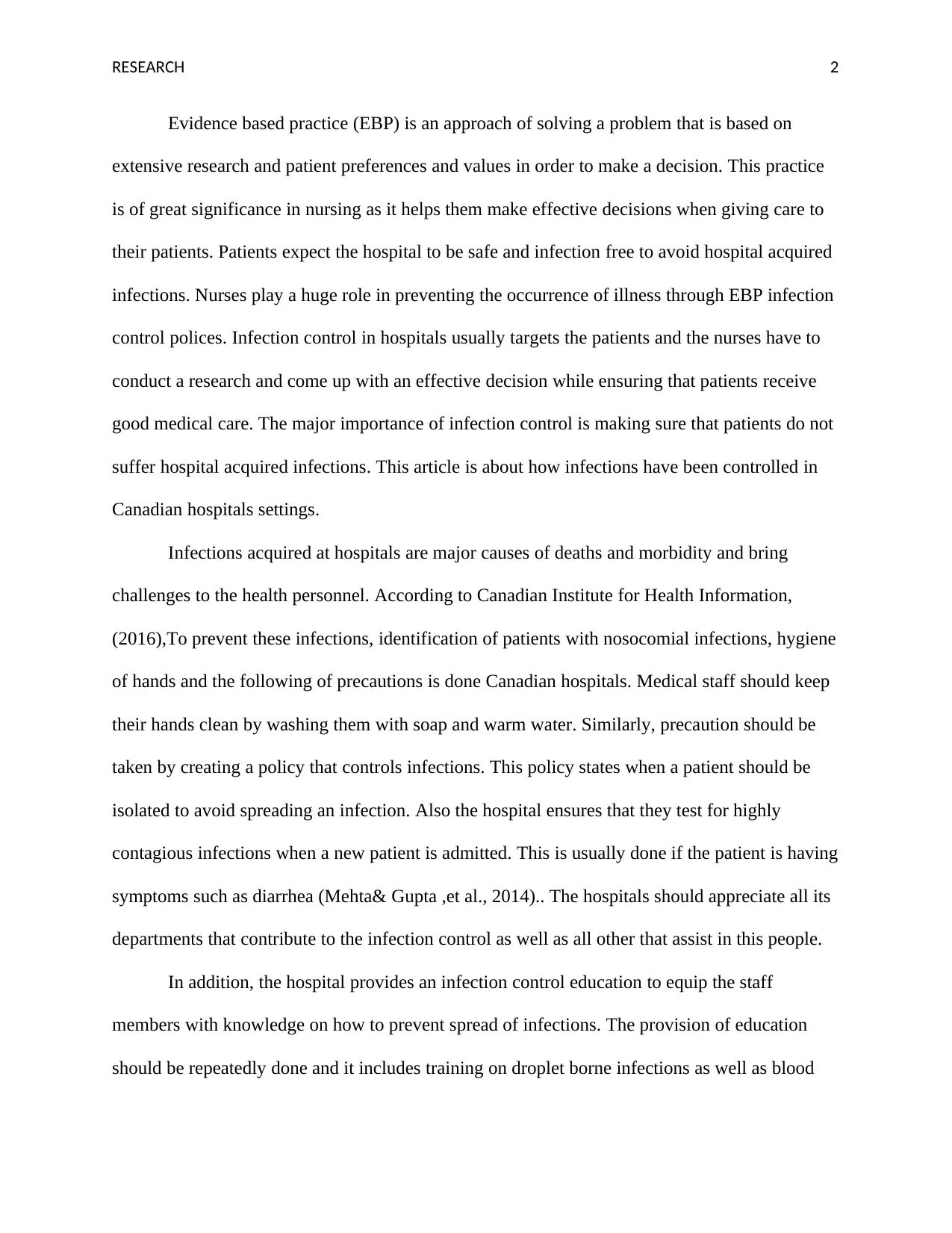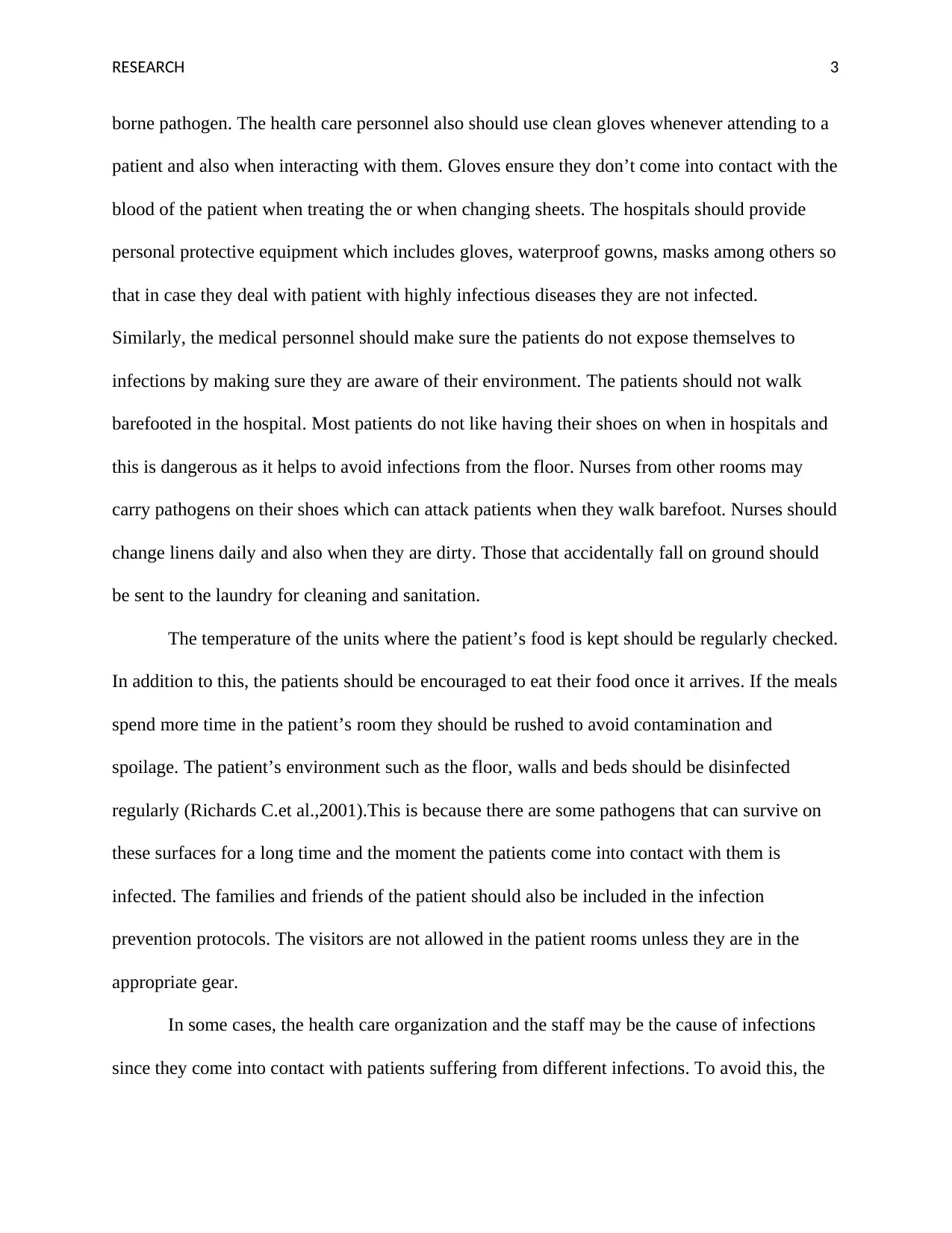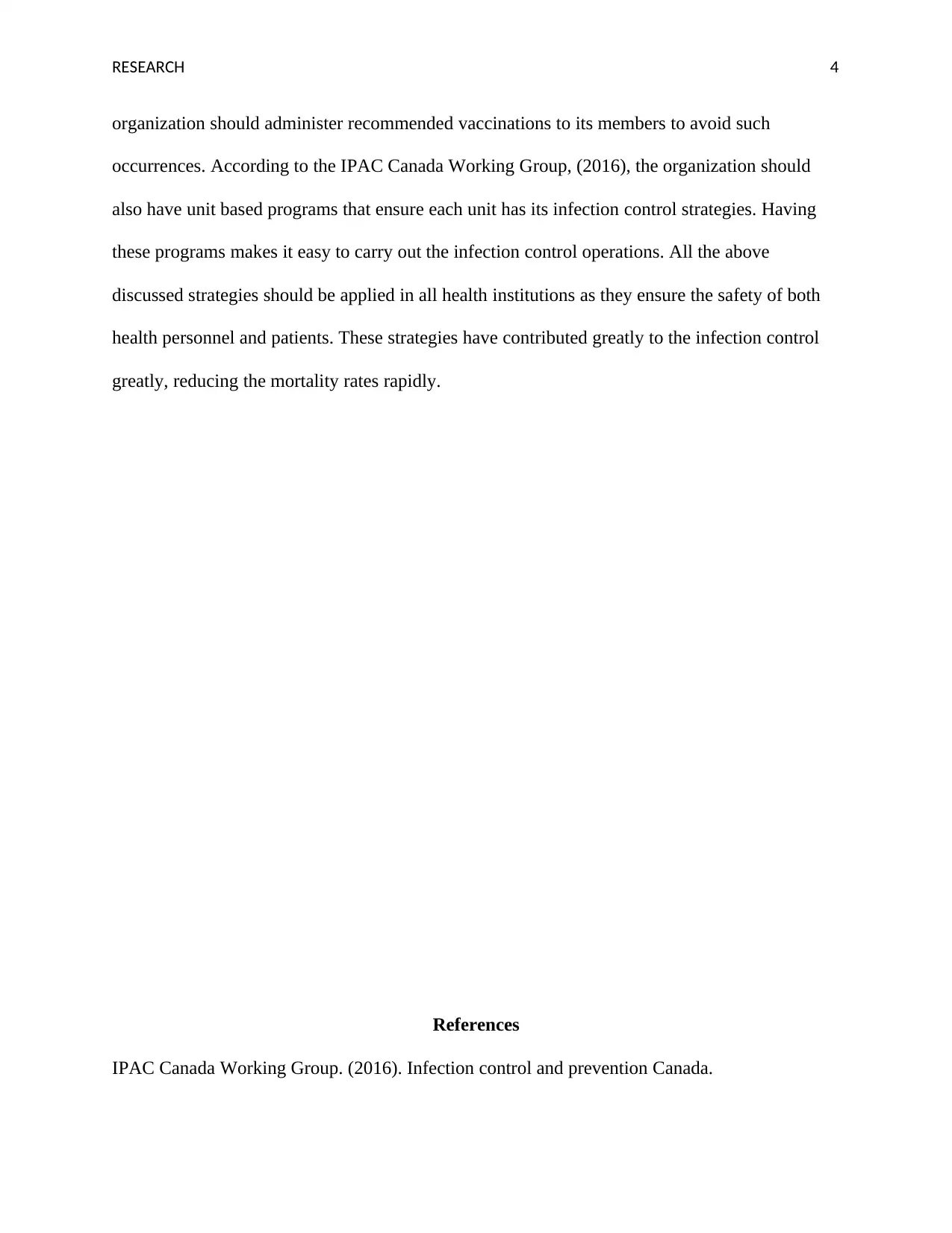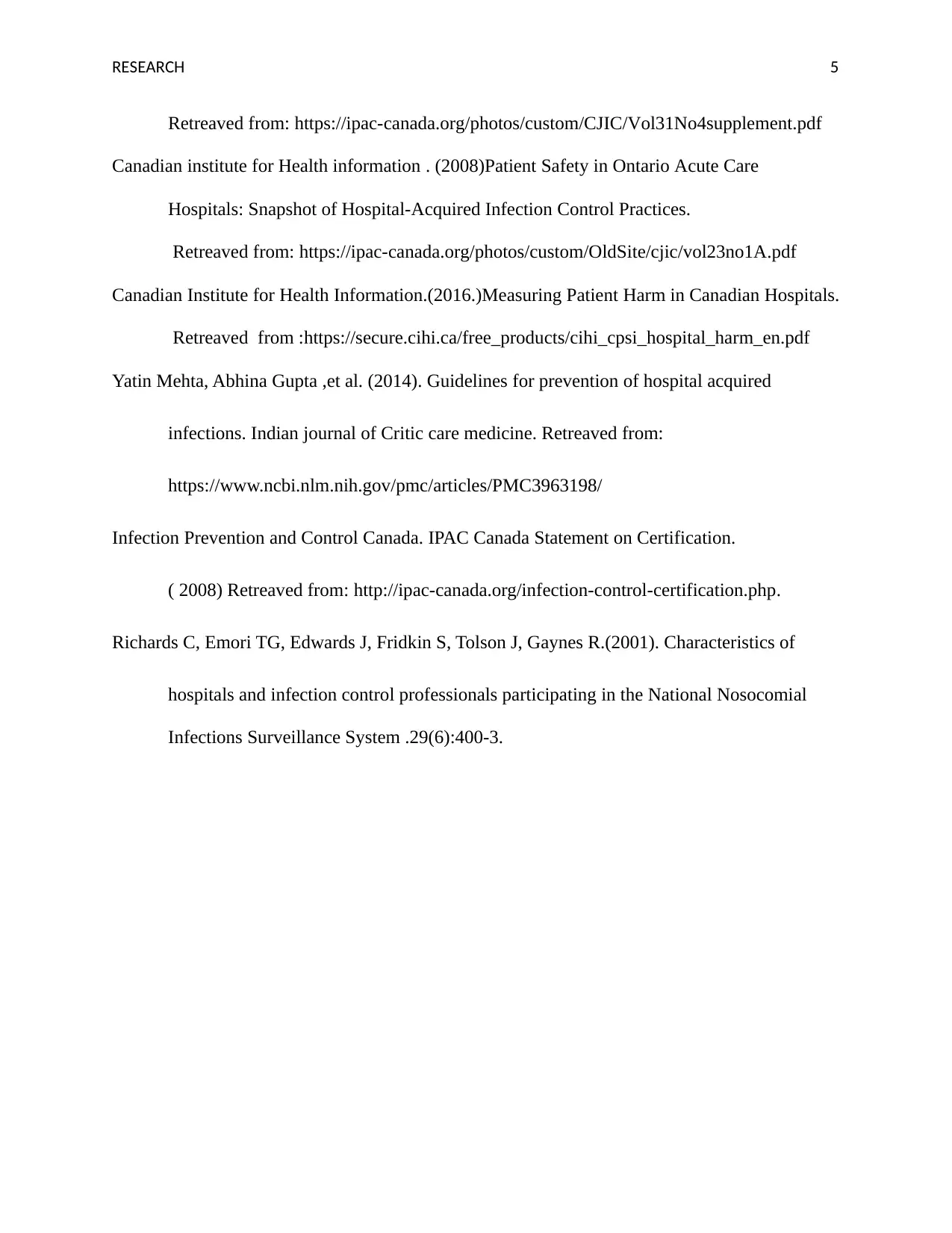Evidence-Based Infection Control Practices in Canadian Hospitals
VerifiedAdded on 2022/08/20
|6
|1012
|15
Report
AI Summary
This report focuses on evidence-based practices for infection control in Canadian hospitals. It emphasizes the importance of preventing hospital-acquired infections (HAIs) and improving patient safety. The report discusses various strategies, including hand hygiene, isolation policies, and the use of personal protective equipment (PPE). It highlights the significance of staff education, environmental disinfection, and the involvement of patients and visitors in infection prevention protocols. The report references several key sources, including the Canadian Institute for Health Information and the IPAC Canada Working Group, to support its findings. It underscores the effectiveness of these strategies in reducing mortality rates and ensuring the safety of both healthcare personnel and patients within Canadian healthcare settings. The report emphasizes the need for continuous implementation and improvement of infection control measures across all healthcare institutions.

Running head: RESEARCH 1
Research
Name
Institutional affiliation
Research
Name
Institutional affiliation
Paraphrase This Document
Need a fresh take? Get an instant paraphrase of this document with our AI Paraphraser

RESEARCH 2
Evidence based practice (EBP) is an approach of solving a problem that is based on
extensive research and patient preferences and values in order to make a decision. This practice
is of great significance in nursing as it helps them make effective decisions when giving care to
their patients. Patients expect the hospital to be safe and infection free to avoid hospital acquired
infections. Nurses play a huge role in preventing the occurrence of illness through EBP infection
control polices. Infection control in hospitals usually targets the patients and the nurses have to
conduct a research and come up with an effective decision while ensuring that patients receive
good medical care. The major importance of infection control is making sure that patients do not
suffer hospital acquired infections. This article is about how infections have been controlled in
Canadian hospitals settings.
Infections acquired at hospitals are major causes of deaths and morbidity and bring
challenges to the health personnel. According to Canadian Institute for Health Information,
(2016),To prevent these infections, identification of patients with nosocomial infections, hygiene
of hands and the following of precautions is done Canadian hospitals. Medical staff should keep
their hands clean by washing them with soap and warm water. Similarly, precaution should be
taken by creating a policy that controls infections. This policy states when a patient should be
isolated to avoid spreading an infection. Also the hospital ensures that they test for highly
contagious infections when a new patient is admitted. This is usually done if the patient is having
symptoms such as diarrhea (Mehta& Gupta ,et al., 2014).. The hospitals should appreciate all its
departments that contribute to the infection control as well as all other that assist in this people.
In addition, the hospital provides an infection control education to equip the staff
members with knowledge on how to prevent spread of infections. The provision of education
should be repeatedly done and it includes training on droplet borne infections as well as blood
Evidence based practice (EBP) is an approach of solving a problem that is based on
extensive research and patient preferences and values in order to make a decision. This practice
is of great significance in nursing as it helps them make effective decisions when giving care to
their patients. Patients expect the hospital to be safe and infection free to avoid hospital acquired
infections. Nurses play a huge role in preventing the occurrence of illness through EBP infection
control polices. Infection control in hospitals usually targets the patients and the nurses have to
conduct a research and come up with an effective decision while ensuring that patients receive
good medical care. The major importance of infection control is making sure that patients do not
suffer hospital acquired infections. This article is about how infections have been controlled in
Canadian hospitals settings.
Infections acquired at hospitals are major causes of deaths and morbidity and bring
challenges to the health personnel. According to Canadian Institute for Health Information,
(2016),To prevent these infections, identification of patients with nosocomial infections, hygiene
of hands and the following of precautions is done Canadian hospitals. Medical staff should keep
their hands clean by washing them with soap and warm water. Similarly, precaution should be
taken by creating a policy that controls infections. This policy states when a patient should be
isolated to avoid spreading an infection. Also the hospital ensures that they test for highly
contagious infections when a new patient is admitted. This is usually done if the patient is having
symptoms such as diarrhea (Mehta& Gupta ,et al., 2014).. The hospitals should appreciate all its
departments that contribute to the infection control as well as all other that assist in this people.
In addition, the hospital provides an infection control education to equip the staff
members with knowledge on how to prevent spread of infections. The provision of education
should be repeatedly done and it includes training on droplet borne infections as well as blood

RESEARCH 3
borne pathogen. The health care personnel also should use clean gloves whenever attending to a
patient and also when interacting with them. Gloves ensure they don’t come into contact with the
blood of the patient when treating the or when changing sheets. The hospitals should provide
personal protective equipment which includes gloves, waterproof gowns, masks among others so
that in case they deal with patient with highly infectious diseases they are not infected.
Similarly, the medical personnel should make sure the patients do not expose themselves to
infections by making sure they are aware of their environment. The patients should not walk
barefooted in the hospital. Most patients do not like having their shoes on when in hospitals and
this is dangerous as it helps to avoid infections from the floor. Nurses from other rooms may
carry pathogens on their shoes which can attack patients when they walk barefoot. Nurses should
change linens daily and also when they are dirty. Those that accidentally fall on ground should
be sent to the laundry for cleaning and sanitation.
The temperature of the units where the patient’s food is kept should be regularly checked.
In addition to this, the patients should be encouraged to eat their food once it arrives. If the meals
spend more time in the patient’s room they should be rushed to avoid contamination and
spoilage. The patient’s environment such as the floor, walls and beds should be disinfected
regularly (Richards C.et al.,2001).This is because there are some pathogens that can survive on
these surfaces for a long time and the moment the patients come into contact with them is
infected. The families and friends of the patient should also be included in the infection
prevention protocols. The visitors are not allowed in the patient rooms unless they are in the
appropriate gear.
In some cases, the health care organization and the staff may be the cause of infections
since they come into contact with patients suffering from different infections. To avoid this, the
borne pathogen. The health care personnel also should use clean gloves whenever attending to a
patient and also when interacting with them. Gloves ensure they don’t come into contact with the
blood of the patient when treating the or when changing sheets. The hospitals should provide
personal protective equipment which includes gloves, waterproof gowns, masks among others so
that in case they deal with patient with highly infectious diseases they are not infected.
Similarly, the medical personnel should make sure the patients do not expose themselves to
infections by making sure they are aware of their environment. The patients should not walk
barefooted in the hospital. Most patients do not like having their shoes on when in hospitals and
this is dangerous as it helps to avoid infections from the floor. Nurses from other rooms may
carry pathogens on their shoes which can attack patients when they walk barefoot. Nurses should
change linens daily and also when they are dirty. Those that accidentally fall on ground should
be sent to the laundry for cleaning and sanitation.
The temperature of the units where the patient’s food is kept should be regularly checked.
In addition to this, the patients should be encouraged to eat their food once it arrives. If the meals
spend more time in the patient’s room they should be rushed to avoid contamination and
spoilage. The patient’s environment such as the floor, walls and beds should be disinfected
regularly (Richards C.et al.,2001).This is because there are some pathogens that can survive on
these surfaces for a long time and the moment the patients come into contact with them is
infected. The families and friends of the patient should also be included in the infection
prevention protocols. The visitors are not allowed in the patient rooms unless they are in the
appropriate gear.
In some cases, the health care organization and the staff may be the cause of infections
since they come into contact with patients suffering from different infections. To avoid this, the
⊘ This is a preview!⊘
Do you want full access?
Subscribe today to unlock all pages.

Trusted by 1+ million students worldwide

RESEARCH 4
organization should administer recommended vaccinations to its members to avoid such
occurrences. According to the IPAC Canada Working Group, (2016), the organization should
also have unit based programs that ensure each unit has its infection control strategies. Having
these programs makes it easy to carry out the infection control operations. All the above
discussed strategies should be applied in all health institutions as they ensure the safety of both
health personnel and patients. These strategies have contributed greatly to the infection control
greatly, reducing the mortality rates rapidly.
References
IPAC Canada Working Group. (2016). Infection control and prevention Canada.
organization should administer recommended vaccinations to its members to avoid such
occurrences. According to the IPAC Canada Working Group, (2016), the organization should
also have unit based programs that ensure each unit has its infection control strategies. Having
these programs makes it easy to carry out the infection control operations. All the above
discussed strategies should be applied in all health institutions as they ensure the safety of both
health personnel and patients. These strategies have contributed greatly to the infection control
greatly, reducing the mortality rates rapidly.
References
IPAC Canada Working Group. (2016). Infection control and prevention Canada.
Paraphrase This Document
Need a fresh take? Get an instant paraphrase of this document with our AI Paraphraser

RESEARCH 5
Retreaved from: https://ipac-canada.org/photos/custom/CJIC/Vol31No4supplement.pdf
Canadian institute for Health information . (2008)Patient Safety in Ontario Acute Care
Hospitals: Snapshot of Hospital-Acquired Infection Control Practices.
Retreaved from: https://ipac-canada.org/photos/custom/OldSite/cjic/vol23no1A.pdf
Canadian Institute for Health Information.(2016.)Measuring Patient Harm in Canadian Hospitals.
Retreaved from :https://secure.cihi.ca/free_products/cihi_cpsi_hospital_harm_en.pdf
Yatin Mehta, Abhina Gupta ,et al. (2014). Guidelines for prevention of hospital acquired
infections. Indian journal of Critic care medicine. Retreaved from:
https://www.ncbi.nlm.nih.gov/pmc/articles/PMC3963198/
Infection Prevention and Control Canada. IPAC Canada Statement on Certification.
( 2008) Retreaved from: http://ipac-canada.org/infection-control-certification.php.
Richards C, Emori TG, Edwards J, Fridkin S, Tolson J, Gaynes R.(2001). Characteristics of
hospitals and infection control professionals participating in the National Nosocomial
Infections Surveillance System .29(6):400-3.
Retreaved from: https://ipac-canada.org/photos/custom/CJIC/Vol31No4supplement.pdf
Canadian institute for Health information . (2008)Patient Safety in Ontario Acute Care
Hospitals: Snapshot of Hospital-Acquired Infection Control Practices.
Retreaved from: https://ipac-canada.org/photos/custom/OldSite/cjic/vol23no1A.pdf
Canadian Institute for Health Information.(2016.)Measuring Patient Harm in Canadian Hospitals.
Retreaved from :https://secure.cihi.ca/free_products/cihi_cpsi_hospital_harm_en.pdf
Yatin Mehta, Abhina Gupta ,et al. (2014). Guidelines for prevention of hospital acquired
infections. Indian journal of Critic care medicine. Retreaved from:
https://www.ncbi.nlm.nih.gov/pmc/articles/PMC3963198/
Infection Prevention and Control Canada. IPAC Canada Statement on Certification.
( 2008) Retreaved from: http://ipac-canada.org/infection-control-certification.php.
Richards C, Emori TG, Edwards J, Fridkin S, Tolson J, Gaynes R.(2001). Characteristics of
hospitals and infection control professionals participating in the National Nosocomial
Infections Surveillance System .29(6):400-3.

RESEARCH 6
⊘ This is a preview!⊘
Do you want full access?
Subscribe today to unlock all pages.

Trusted by 1+ million students worldwide
1 out of 6
Related Documents
Your All-in-One AI-Powered Toolkit for Academic Success.
+13062052269
info@desklib.com
Available 24*7 on WhatsApp / Email
![[object Object]](/_next/static/media/star-bottom.7253800d.svg)
Unlock your academic potential
Copyright © 2020–2025 A2Z Services. All Rights Reserved. Developed and managed by ZUCOL.




